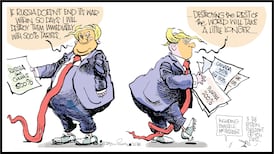The most significant event in Irish politics over the past few weeks was not the return of the Dáil, but the firm commitment by Tánaiste Micheál Martin to lead Fianna Fáil into the next general election. His decision will boost his party’s prospects and, even more importantly, be a critical factor in the negotiations about government formation which will inevitably follow.
What was striking about Martin’s commitment to remain in Irish politics was that he linked it to a scathing attack on Sinn Féin for the way the party continues to “triumphalise the horrible deeds that the [IRA] did”. Asked whether he worries if that rhetoric “infects” young voters, he spoke about the need to not “whitewash history”.
The Fianna Fáil leader cited the importance of the recently released, brilliant and heart-rending film Face Down. It tells the story of German honorary consul and businessman Thomas Niedermayer, who was kidnapped from his home in Belfast and murdered by the IRA in the 1970s and the devastating long-term consequences for his family.
The outraged response of Sinn Féin housing spokesman Eoin Ó Broin showed that Martin had hit a sore point, even if the party, and much of the media, continues to proclaim that young people don’t care about the atrocities committed by the IRA and glorified by the republican movement to this day.
READ MORE
The next election is going to be a crucial contest for the future of Irish democracy and it is in that context that Martin’s decision is hugely important. Over the past year or so the prevailing political narrative has been that the two main parties in the Coalition have little chance of retaining power, despite their impressive handling of Covid and the economy, and that Sinn Féin is almost certain to lead the next government.
Martin took a well justified swipe at the media for promoting this narrative, telling journalists to “stop cheerleading [Sinn Féin] along as if it’s a slam dunk. It’s not. It’s very fragmented. The options are very wide.”
He pointed to the way the political consensus in advance of the 2016 general election that Fianna Fáil was on the ropes had turned out to be very wide of the mark. He could equally have referenced the last election in 2020 when the speculation right up to the day the election was called was whether Fine Gael or Fianna Fáil would be in power. In the event, the Sinn Féin surge shattered all the preconceptions and Irish politics entered a new phase with three parties winning roughly the same level of support.
Wide consensus
This time a wide consensus has developed in the media suggesting that Sinn Féin will inevitably lead the next Government. This perception has percolated the political mood with Sinn Féin over-confident of victory and some in Fianna Fáil and Fine Gael resigning themselves to defeat.
Martin’s decision to stand and fight should stiffen the resolve of his colleagues in the two big Coalition parties that there is nothing inevitable about the outcome. While it is almost certain that Sinn Féin will emerge as the largest party, that is no guarantee of government.
Irish political history is littered with occasions when the biggest party did not form the government. It happened after the elections of 1948, 1954, 1973, 1981 and 1982 and again in 1994 without an election. In all these instances Fianna Fáil had a far bigger share of votes and seats than Sinn Féin is likely to at the next election, but was denied power by a combination of opponents.
The constituency revision has given all the parties the clarity they need to start preparing for the election and, contrary to some claims, the new boundaries have not given an advantage to any particular party.
A rough assessment of the outcome for the new 174-member Dáil, based on its most recent Irish Times polling figure of 31 per cent, gives Sinn Féin about 60 seats. Short of a surge during the campaign similar to 2020, that will leave the party more than 25 seats shy of being able to take the reins of power – unless it can persuade one of the other big parties into a coalition.
Fine Gael has ruled that out in emphatic terms and while there is some ambiguity about the Fianna Fáil position, the party can hardly do it as long as Martin remains leader.
If Fianna Fáil and Fine Gael can win about 20 per cent of the vote each they should have more than 70 seats between them, particularly if their supporters transfer to each other in significant numbers. That would leave them in a stronger position than Sinn Féin to negotiate a coalition with smaller parties or Independents.
The conduct of the campaign will have a vital bearing on the outcome, and it is here that Martin’s leadership will be crucial, given his debating ability and the wide public respect he achieved during his stewardship of the taoiseach’s office.
He is easily the strongest weapon in the Fianna Fáil armoury and his leadership will help to maximise the party’s performance by promoting transfers from other parties and Independents. There is every chance that, despite all the predictions to the contrary, the centre can hold.















